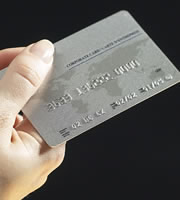Consumers lose, businesses win in latest credit card rate shift

April 30, 2015
Current averages:
- Average consumer credit card rate, overall market: 17.18 percent
- Average consumer non-rewards credit card rate: 15.57 percent
- Average consumer rewards credit card rate: 17.87 percent
- Average student credit card rate: 17.04 percent
- Average business non-rewards credit card rate: 14.89 percent
- Average business rewards credit card rate: 15.50 percent
The U.S. bank prime rate remains at 3.25 percent.
There were some mixed signals in the credit card market during April. Consumer credit card rates moved higher due to a rise in the non-rewards category, while business credit cards saw a drop their rewards category.
It is entirely possible that credit card companies are taking different views on the credit outlook for consumers and businesses. Consumers have seen an upturn in credit card debt outstanding for four straight years now, and the previously-robust trend in job growth recently faltered. According to the Bureau of Labor Statistics, job creation in March was just 126,000, less than half the average for the prior 12 months.
Growing debt burdens and a weakening job outlook may explain why credit card companies seem more concerned with the creditworthiness of consumers than of businesses, but the sobering thing to remember is that what affects consumers ultimately affects businesses as well.
Consumer credit cards
The average rate on consumer non-rewards cards rose by seven basis points to 15.57 percent. While this is only one basis point higher than where that average started the year, what is significant is that 15.57 percent is the highest that average has been in the four years for which this survey has records. At a time when mortgage rates and many other interest rates are near record lows, the relatively high level of consumer credit card rates may reflect a degree of concern about unsecured consumer credit.
With the average rate for rewards credit cards holding steady at 17.87 while the average for non-rewards cards rose, the gap between the two closed by seven basis points to 2.30. That is the lowest this gap has been since one year ago. The shrinking of that gap potentially lowers the cost to consumers of participating in rewards programs, though consumers can eliminate that cost altogether by paying off their credit card balances in full every month.
Student credit cards
While consumer and business credit cards moved in opposite directions in April, student credit cards remained unchanged. Their average rate of 17.04 percent has been in place since the end of 2014.
Business credit cards
In contrast to the rise in the overall average rate for consumer credit cards, business rewards credit cards saw their average rate drop by 12 basis points to 15.50 percent. This was due to the return of a credit card offer that had taken a hiatus from accepting new business for several months. The availability of credit cards at different rate points is a factor in the overall rate environment.
The one thing that consumer and business credit cards had in common is both saw the gap between their rewards and non-rewards categories narrow in April. For business credit cards, the spread between the two averages is now down to 0.61 percent, its lowest level since last September.
Excellent credit vs. average credit
Changes in the consumer credit card category narrowed the spread between the highest and lowest rate tiers by three basis points to 4.06 percent. Normally, a narrowing of this spread represents an easing of credit concerns, but in this instance it was more of a fluke. It resulted from a rise in rates on an offer for a secured credit card. Because this card only has one rate tier, it technically was recorded as an increase in the lowest rate tier, but the nature of the card suggests that it reflects growing concern about consumers with lower credit ratings.
In total, IndexCreditCards.com surveys information from nearly 50 different credit cards, and includes multiple credit-rating tiers from many of those cards. Examples of offers surveyed include American Express, Capital One, Chase, Citi, Discover, and other MasterCard and Visa branded cards. The information compiled not only demonstrates trends in credit card rates over time, but also indicates the different values credit card companies put on different target markets (consumer, business, etc.), as evidenced by the differences between rates for those markets.
Disclaimer:The information in this article is believed to be accurate as of the date it was written. Please keep in mind that credit card offers change frequently. Therefore, we cannot guarantee the accuracy of the information in this article. Reasonable efforts are made to maintain accurate information. See the online credit card application for full terms and conditions on offers and rewards. Please verify all terms and conditions of any credit card prior to applying.
This content is not provided by any company mentioned in this article. Any opinions, analyses, reviews or recommendations expressed here are those of the author’s alone, and have not been reviewed, approved or otherwise endorsed by any such company. CardRatings.com does not review every company or every offer available on the market.
Published